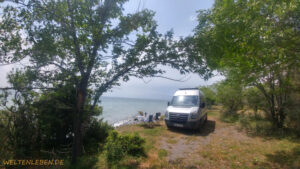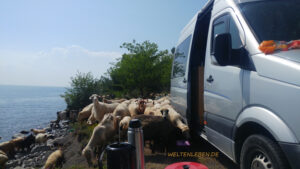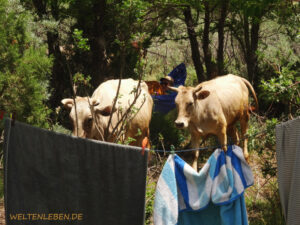Although situated at an altitude of almost 2000 metres, the weather on the shores of Lake Sevan is mostly mild and we spend relaxing days in hammocks and camping chairs.
The only visitors we get are the herds of cows and goats that pass by every day.

Oh, how beautiful itˋs at Lake Sevan – with trees and bushes at 1900 metres!

Friendly visitor at coffee time 😉

This is the life of the world 😉
In terms of area, Armenia is less than half the size of Bavaria, but it has an average altitude of just under 1,800 metres, making it one of the highest countries in the world! The hilly and mountainous landscape and the road conditions mean that we can usually only travel at an average speed of 50-60 kilometres per hour.
We continue south. After Lake Sevan, we shorten the route somewhat, at least in terms of the distance to be covered, and take an old connecting road. This way, we are immediately immersed in a wonderful natural landscape again and discover some species of birds that are rare or even non-existent in Europe, as well as brightly flowering meadows, just by driving past.
On this day, our route takes us to the top of the Vardenyats (Selim) Pass. We spend the night there and this becomes the highest campsite on our journey so far (2439 m). Here, too, the meadows are still lush green and in full bloom. This again attracts a fauna that was almost completely unknown to us in its diversity and splendour. We encounter countless insects, reptiles and birds at every turn.
Click on the following gallery to get a small impression:
The destination of this stage is an observation point near the village of Shatin. Here we want to try our luck again to see brown bears. The last time we succeeded in doing so was on a tour in Slovenia.
The lookout point is opposite a cliff, in the garden of a private property. However, it is freely accessible to all people interested in nature and has been built in cooperation with various nature conservation organisations. Besides the bears, there is also the chance to see the Bezoar goats, which have become very rare in the meantime. There are only about 1,000 of these animals left and they are the “original goats”. In other words, the ancestors of all domesticated goats today.
We try our luck twice in the evening hours and twice before sunrise and can observe some of the Bezoar goats during their daring search for food in the steep slopes. Although we know from other travellers that they have already had the luck to observe bears at first go, unfortunately this is not on our side in all four attempts. Nevertheless, it was very worthwhile to visit this place, because apart from the unique animals, we also meet two extremely warm Armenians with whom we spend an entertaining evening 😉
Follow us to this great region by clicking on the following gallery:
In the following days, we continue to move around the Vayoz Dzor region. This is one of the least populated regions in Armenia, which is no wonder, since over 1/3 of Armenians live in the capital Yerevan!
On various hikes, meanwhile always more than 30 degrees in the shade, we discover more great corners, pure nature and get to know many great people. Click on the following gallery for a few colourful impressions:
It is not only the landscape that we enjoy discovering. The provision of daily necessities also brings with it some peculiarities that are typical of the country. For example, especially in smaller shops, there is often no milk on offer. However, you will often find the typical Armenian fresh yoghurt (“Matsun”) in a 1-litre jar in the display. The bread of the Armenians is the “Lavash” – a huge but only a few millimetres thick pastry which is at least as tasty as freshly baked pancakes 😉 Besides the fresh version, it is also available dried, which is supposed to keep the lavash for up to a year!
And it’s possible to have coffee beans freshly ground almost anywhere. We are also in the country at the right time for the apricot harvest (June/July) and can buy the tasty fruits on every corner or pick them ourselves. However, we are particularly fond of the large selection of unpackaged confectionery, which is also offered in many shops. Almost every time we go shopping, we put all kinds of biscuits in our plastic bags, which we collect for reuse. 🙂
Looking for an appetiser? Click on the following gallery:
During our time in the country, the conflict between Armenia and its neighbour Azerbaijan fortunately does not manifest itself in active fighting. This allows us to move further south.
On our walks, snakes flee into the bushes more and more often when they notice our footsteps. It’s worth stepping a little harder to let them know we’re coming by the vibrations 😉 The landscape becomes increasingly dry and barren, the temperatures rise further to over 40 degrees during the day and “only” 27 degrees at night. What could be more fitting than to spend a few days at the river of the Shaki waterfall and enjoy it in peace when the tourist hustle and bustle has died down again in the early evening hours.
You can find a few pictures by clicking on the following gallery:
We crown the most south-eastern point of our trip with a cable car ride to Tatev Monastery. The cable car, called “Wings of Tatev”, is one of the longest cable cars in the world with a length of 5.75 km. It takes only a few minutes to reach the monastery on the other side of the Vorotan Gorge and saves a good 14 km of serpentine driving.
Come along to the monastery by clicking on the following gallery:
For more than 12 months we have been heading east. Reaching the monastery marks a turning point and we are now heading west for the first time on this journey, only about 50 km as the crow flies from the Iranian border.
Join us in the next post as we continue through our last summer weeks in Armenia. After that, there will be a time jump to our current travel destination and the regions where we are escaping the winter.
Pothole-free wishes and greetings! 😉
Sophia and Chris






































